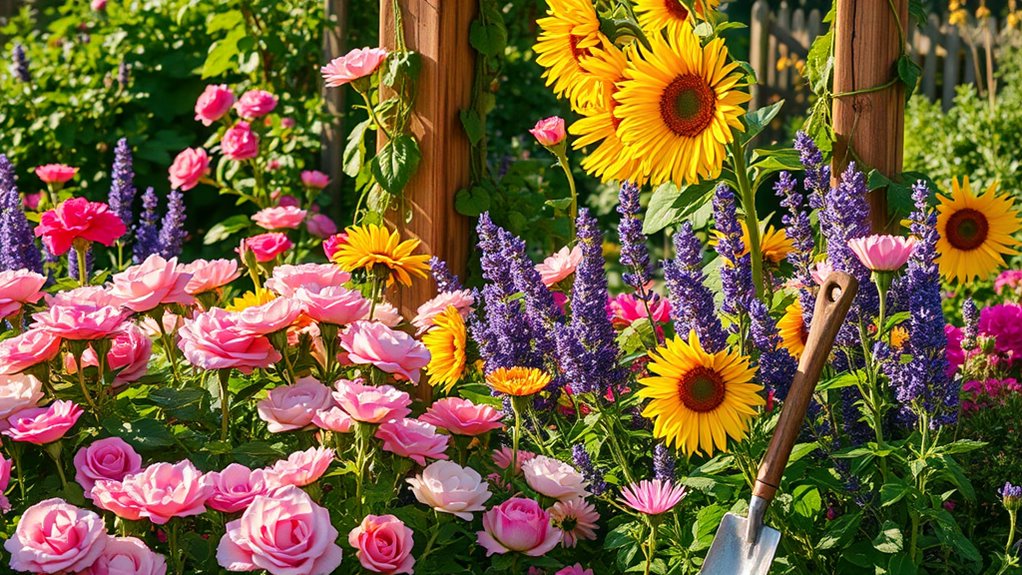What I Did to Make My Garden Bloom All Season
A garden can either wilt in the summer heat or burst with vibrant color; the difference lies in the gardener’s choices. You’ve chosen long-blooming perennials like coneflowers and salvia, paired with striking annuals for a continuous display. But how you prepare your soil and manage nutrients is just as crucial. Discovering the right watering techniques and maintenance strategies can ensure your blooms thrive all season long. Curious to learn how to achieve this balance?
Choosing the Right Flowers for Continuous Bloom
When it comes to creating a garden that bursts with color throughout the seasons, selecting the right flowers is essential.
Opt for long blooming flowers like coneflowers, salvia, and daylilies; they’ll keep your garden vibrant from spring to fall.
By choosing a mix of annuals and perennials, you ensure a continuous display that captivates the eye and nurtures the soul.
Incorporating seasonal bloomers like chrysanthemums and asters will also enhance your garden’s appeal in the fall.
Your garden will thrive, and so will you!
Soil Preparation and Nutrient Management
Quality soil is the foundation of a thriving garden, and preparing it properly can make all the difference in your plants’ health and vibrancy.
Focus on these crucial steps:
- Test soil pH and nutrient levels
- Amend with organic matter like compost
- Incorporate slow-release fertilizers
- Ensure good drainage
- Mulch to retain moisture and suppress weeds
Additionally, understanding soil testing techniques can help you identify specific nutrient deficiencies and tailor your amendments accordingly.
With careful preparation, your garden will flourish!
Effective Watering Techniques
To ensure your garden thrives, mastering effective watering techniques is essential, as the right amount and method can significantly influence your plants’ growth and resilience.
Water deeply and less frequently to encourage strong root systems. Early mornings or late afternoons are ideal for watering, minimizing evaporation.
Use mulch to retain moisture and reduce weeds, keeping your garden vibrant and flourishing throughout the season. Additionally, appropriate watering schedules can help tailor your watering to your plants’ unique needs and environmental conditions.
Companion Planting for Enhanced Growth
While some plants thrive on their own, pairing them with the right companions can elevate your garden’s productivity and health.
Consider these powerful combinations:
- Basil and tomatoes to boost flavor
- Marigolds to repel pests
- Peas to enrich soil with nitrogen
- Chives to enhance growth in carrots
- Nasturtiums to attract beneficial insects
Embrace companion planting for a vibrant and flourishing garden! Additionally, implementing companion planting benefits in your garden design can significantly improve pest resistance and overall plant health.
Pruning and Deadheading for Prolonged Blooms
After enhancing your garden’s health through companion planting, you’ll want to ensure those vibrant blooms last as long as possible. Pruning and deadheading are essential practices that keep your plants thriving. Regularly removing spent flowers not only encourages new growth but also prevents diseases. Here’s a quick guide to help you:
| Action | Best Time | Tool Needed |
|---|---|---|
| Pruning | Early spring | Sharp shears |
| Deadheading | After flowering | Snips |
| Cleaning Up | At season’s end | Rake |
| Fertilizing | Mid-season | Handheld spreader |
In addition to enhancing aesthetics, proper pruning techniques can significantly improve overall plant health and vigor.
Seasonal Care and Maintenance Tips
As seasons change, your garden requires tailored care to ensure it remains vibrant and healthy throughout the year.
Here are some essential maintenance tips:
-
Adjust your watering schedule based on rainfall and temperature.
-
Apply seasonal fertilizers for optimal growth.
-
Mulch to retain moisture and suppress weeds.
-
Monitor for pests and diseases regularly.
-
Rotate crops annually to maintain soil health.
Incorporating these practices can help you achieve optimal plant health and a thriving garden all year round.
Stay passionate and committed to your garden’s success!

